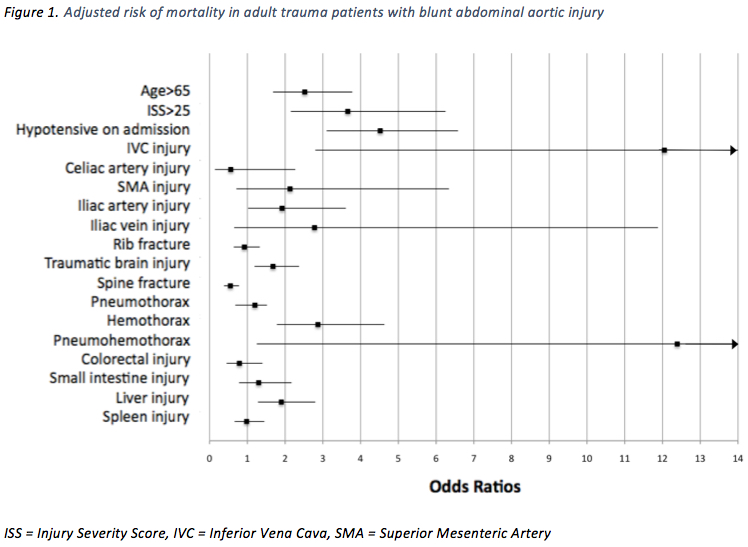Predictors of Blunt Abdominal Aortic Injury in Trauma Patients and Analysis for Mortality
Brian Sheehan, MD1, Areg Grigorian, MD1, Christian de Virgilio, MD2, Roy M. Fujitani, MD1, Nii-Kabu Kabutey, MD1, Michael Lekawa, MD1, Sebastian D. Schubl, MD1, Jeffry Nahmias, MD1.
1University of California, Irvine, Orange, CA, USA, 2Harbor UCLA Medical Center, Torrance, CA, USA.
Objectives: Blunt abdominal aortic injury (BAAI) occurs in <0.1% of blunt trauma. A previous multi-institutional study found an associated mortality rate of 39%. We sought to identify risk factors for BAAI and risk factors for mortality in patients with BAAI using a large national database.
Methods: The Trauma Quality Improvement Program (2010-2016) was queried for individuals with blunt trauma. Patients with and without BAAI were compared. Covariates were included in a multivariable logistic regression model to determine mechanisms of injury, exam findings, and concomitant injuries associated with increased risk for BAAI. A multivariable analysis was performed for mortality in patients with BAAI.
Results: From 1,056,633 blunt trauma admissions, 1,012 (0.1%) were identified with BAAI. The most common mechanism was motor vehicle accident (MVA) (57.5%). More than half the patients had at least one rib fracture (54.0%), or a spine fracture (53.9%), 20.8% had hypotension on admission and 7.8% had a trunk abrasion. The average length of stay was 13.4 days and 24.6% required laparotomy, with 6.6% receiving an endovascular repair and 2.9% an open repair. The risk of death in those treated with endovascular vs. open repair was similar (p=0.28). On multivariable analysis, MVA was the mechanism associated with the highest risk of BAAI (OR:4.68, CI:3.87-5.65, p<0.001) followed by pedestrian struck (OR:4.54, CI:3.47-5.92, p<0.001). Other factors associated with BAAI included hypotension on admission (OR:3.87, CI:3.21-4.66, p<0.001), hemopneumothorax (OR:3.67, CI:1.16-11.58, p<0.001), abrasion to the trunk (OR:1.49, CI:1.15-1.94, p=0.003), and rib fracture (OR:1.46, CI:1.25-1.70, p<0.001). The overall mortality rate was 28.0%. Of the variables examined, the strongest risk factor associated with mortality was hemopneumothorax (OR:12.49, CI:1.25-124.84, p=0.03) followed by inferior vena cava injury (IVC) (OR:12.05, CI:2.80-51.80, p=0.001) (figure 1).
Conclusion: In the largest nationwide series to date, BAAI continues to have a high mortality rate with hemopneumothorax and IVC injury associated with the highest risk for mortality. The mechanism most strongly associated with BAAI is MVA followed by pedestrian struck. Other risk factors for BAAI include rib fracture and trunk abrasion. Providers must maintain a high suspicion of injury for BAAI when these mechanisms of injury, physical exam or image findings are seen. 
Back to 2019 Abstracts
